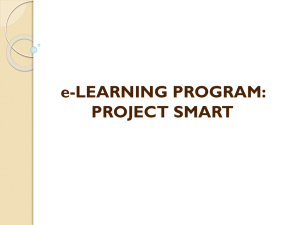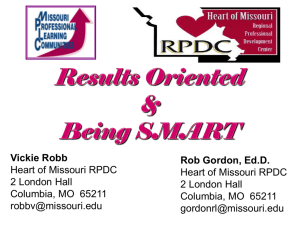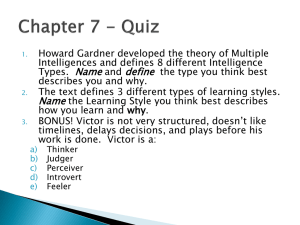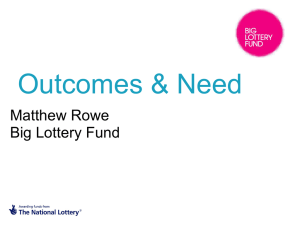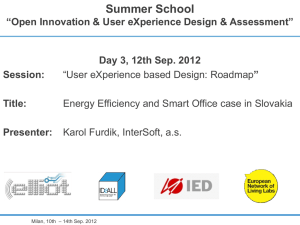smart goal
advertisement
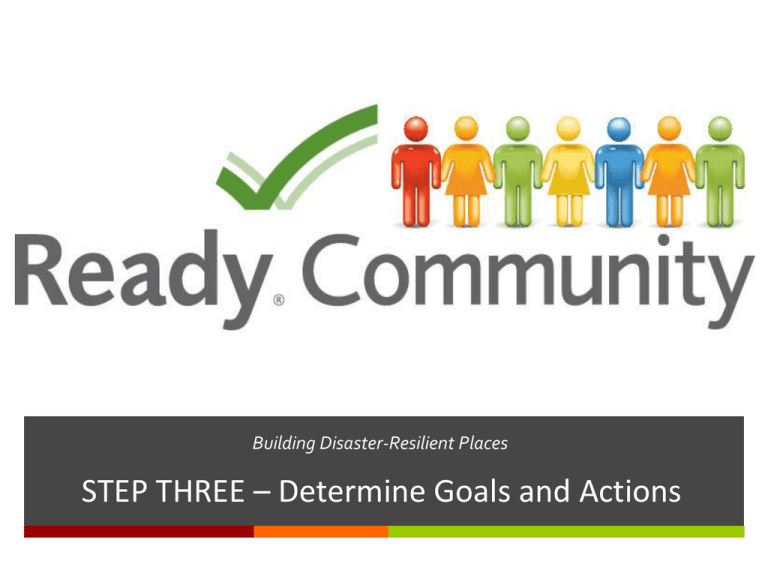
Building Disaster-Resilient Places STEP THREE – Determine Goals and Actions 2 A Review of What is Involved Step 1: Form a Collaborative Planning Team Step 1: Step 2: Step 3: Step 4: Step 5: Step 6: Step 2: Understand the Situation Step 3: Determine Goals & Actions Step 4: Plan Development Step 5: Plan Preparation, Review, & Approval Form a Collaborative Planning Team Understand the Situation Determine Goals & Actions Develop the Plan Prepare, Review, & Approve the Plan Implement & Maintain the Plan Step 6: Plan Implementation & Maintenance 3 Overview In this step, your team will: Learn about scenario planning Test the scenario planning process Explore the elements of SMART goals Create SMART goals that respond to your key hazards Outline actions needed to accomplish goals 4 Scenario Planning: What is It? A way to develop long-term plans based on: Assessment of hazards/threats the community may face Exploration of “What If” situations related to those threats or hazards Examination of goals and actions that can help your community respond effectively 5 Stages of Scenario Planning Identifying Assessing Building Threats Vulnerability Scenarios Identify hazard/threat you want to address. Determine the nature & level of the community’s vulnerability. Use results of the first two stages to focus on the scenario you wish to explore. Can your community do something about the hazard or threat? Identify the major factors affecting your community’s vulnerability to the identified hazard or threat. Is hazard/threat one that can be applied to a scenario planning activity? Adapted from: JISC InfoNet, 2011. Generating Options Develop possible goals for addressing your scenario. What goals can your community select to either respond to or mitigate the threat? Testing Options Begin Developing Action Plans Identify possible actions related to each goal being considered Decide on actions you want to address related to the goals you have identified. Ask yourself, “How well will each of the possible actions work in my community?” Develop actions that best fit each of your goals. Scenario Planning: Working Up to Goals and Actions How will you respond? Flood Scenario Debrief DISCUSSION. What went well? What didn’t go well? Did you identify solid goals? Did you have the resources you needed? What questions did this raise? Thinking about Your Plan DISCUSSION. What top hazards did you identify in Step Two? What needs to happen to respond to these hazards? 9 Emergency Support Functions Which of these should become part of your goals? 6 7 8 9 5 11 4 12 3 2 1 10 13 Emergency Support Functions 14 15 10 Developing Goals What is a goal? An observable and measurable outcome that you want to achieve within a specific period of time. It is a statement that is SMART 11 SMART Goals Specific Measurable Attainable Relevant Time Framed • What do you want to achieve? • Why is this goal important? • Where will you focus your efforts? • How do you plan to measure progress towards your goal? • What is the end result as well as the milestones along the way? • Do you have the resources to achieve the goal? (People, organizations, money, physical resources, skills, attitude, etc.) • Are there factors that might prevent you from achieving these goals? • Is this an important enough goal for your community to pursue? • Is it something that matters (or should matter) to your community? • Is it one that will bring benefit to your community? • When do you want to achieve this goal? • What is the target date for accomplishing the goal? 12 SMART Goal Example ESF# 4: Firefighting Example: Not SMART – Improve coordination of local volunteer fire departments for responding to large scale fires. Attainable Time-Framed Specific SMART – By July 14, 2013, develop and adopt a county- wide communication system that will allow alerts to reach all county volunteer fire departments within ten minutes of a large scale fire detection. Measurable Relevant 13 SMART Goal: Example Specific Measurable Attainable Relevant Time-Framed ESF#15: Emergency Public Information Not SMART: Alert everyone in the flood-prone areas of a flood threat. Can you identify the SMART elements included in the following goal? SMART – 100% of persons in the county’s flood-prone area will be notified within 4 hours of an evacuation order being issued by state or county/local emergency management personnel. Getting to Work on SMART Goals For each ESF that your team has identified as relevant to your hazard, write a SMART goal that describes what you want to achieve. 15 Thinking through Goals & Actions ESF#15: Emergency Public Information SMART GOAL: 100% of persons in the county’s flood-prone area will be notified within four hours of an evacuation order being issued by state or county/local emergency management personnel. Actions to be Performed: Within six months, devise a neighborhood communication plan using both established local organizations and trained volunteers to communicate warnings. Within three months, develop a plan to broadcast emergency information using all available media outlets serving the local area, giving particular attention to hearing impaired resources as well as non-English speaking outlets. 16 Ready to CreateYour Actions Using your ESF-related SMART goals, write the actions that will help you accomplish each goal. 17 Homework: Refining Goals and Actions By the next session: Fine tune the SMART goals and actions Be prepared to present and finalize at the next meeting 18 Questions and Next Steps Any topics need clarification? Any concerns about the homework to be done prior to the next meeting? Announcement of the next meeting: date, time, location 19 Contact Information Building Disaster-Resilient Places


